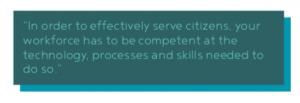This article is an excerpt from GovLoop’s guide, “Government’s Customer Experience Playbook.” Download the full guide here.
There are 168 hours in a week. For the average worker, about a quarter of those are spent in an office – which, in government, can sometimes be limited in terms of staff and technology.
That’s a lot of time to put up with a situation that’s inefficient – both for the people themselves and government, which is constantly looking for ways to maximize its workforce. And yet, because of shifting demands in workforces and technology, that’s often what happens.
But it doesn’t have to be that way. GovLoop recently interviewed Joey Zumaya, Manager of the Public Sector at LinkedIn Learning, about how talent developers in government can maximize workforce engagement and mission outcomes. LinkedIn Learning is a training management and measurement platform that offers thousands of courses.

Uniquely challenging to government, millennials and baby boomers often share the same office space and perform similar jobs, but have very different technology skills and expectations. While one might find a 2008 word processing interface outmoded, another might find it newfangled.
This skills and communication gap that persists in government can directly seep into employee engagement and outward-facing customer experience (CX), slowing response times and leading to inconsistent responses.
Talent developers need to identify these skills gaps and address them. Government executives, therefore, should make learning and development (L&D) a priority for agencies, and offer more autonomy to talent developers to select and implement the best programs.
They are. The good news is that despite tightening budgets across many agencies, 43% of talent developers surveyed in a recent LinkedIn Learning report said they expected an increase in funding. Furthermore, 59% spend more on online learning than they did three years ago.
Traditional email marketing has been a productive tool for engaging employees, but agencies can still struggle to reach managers and understand specific needs.
That’s where online L&D comes in, offering better reach and precision. Online dashboards can communicate areas of strength and weakness to show managers and employees a clear path to improved performance with recommended courses.
LinkedIn Learning provides a central hub for online learning, where 50 new courses are added every week. That same platform also pinpoints skills gaps and tracks the effectiveness of prescribed courses.
The result is greater than content and productive employees. A more connected, complete workforce helps governments alleviate strains and strengthen CX.
“When government agencies think about shifts in technology and generations, there’s a little bit of anxiety and a little bit of risk perceived,” Zumaya said. “But we see that there’s much more reward than risk.”

